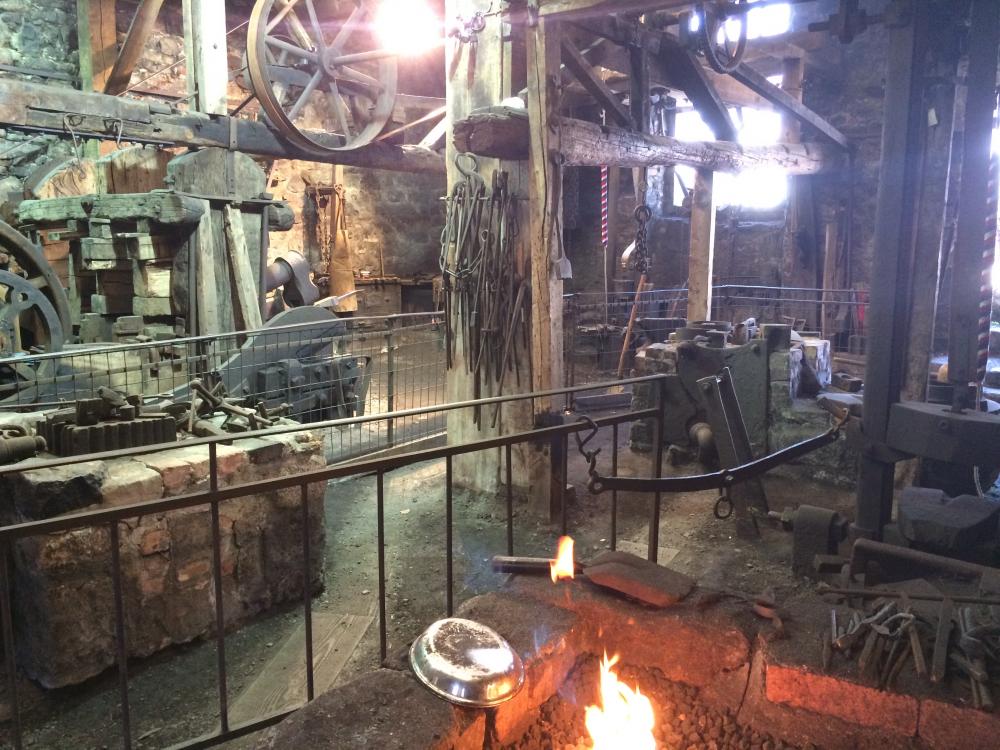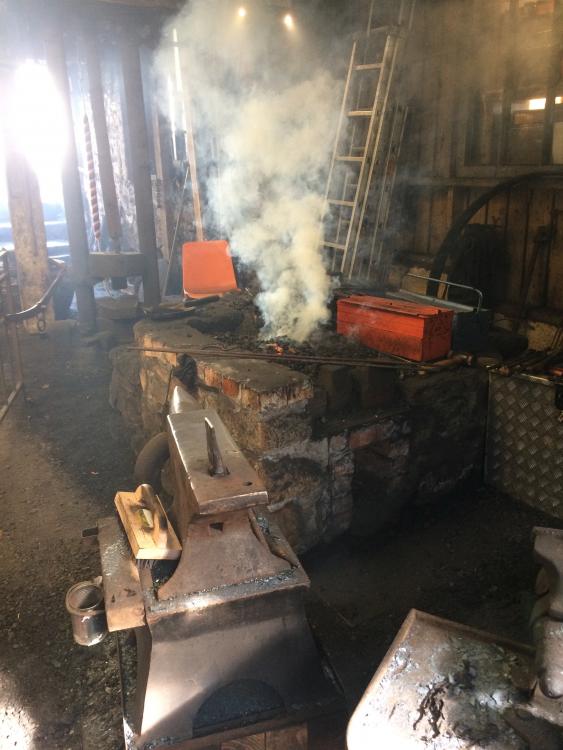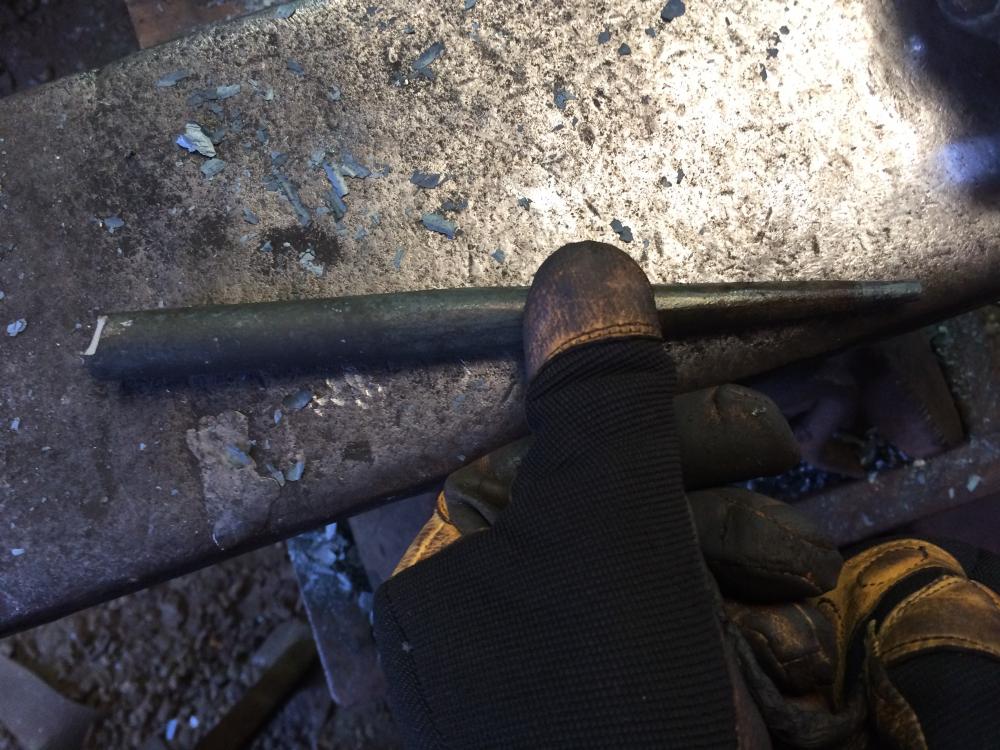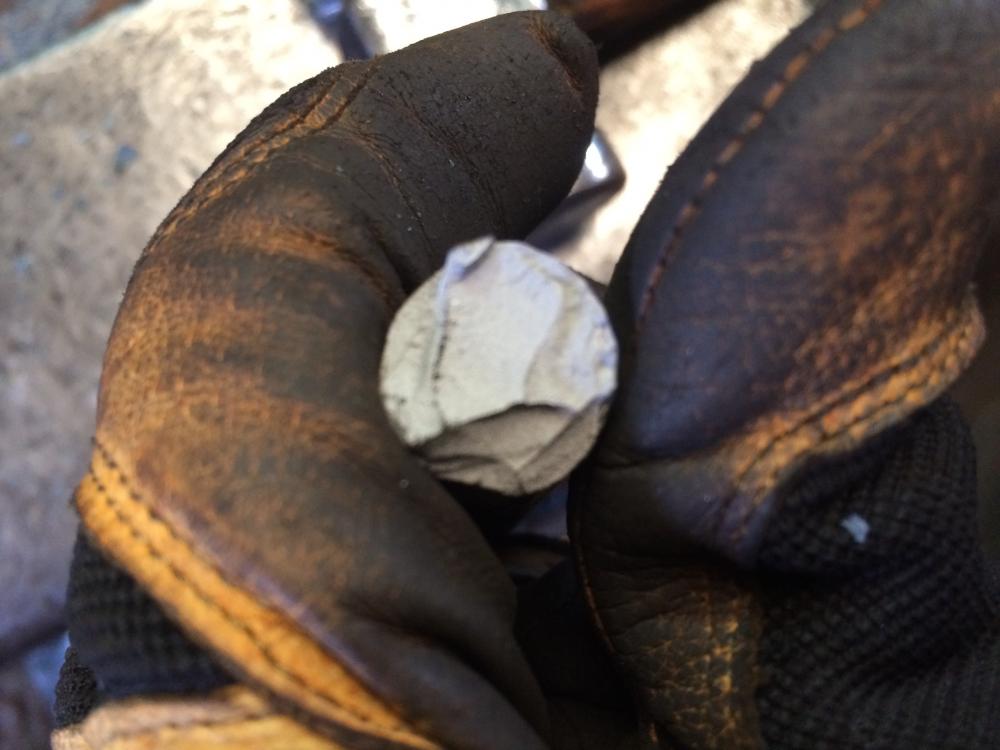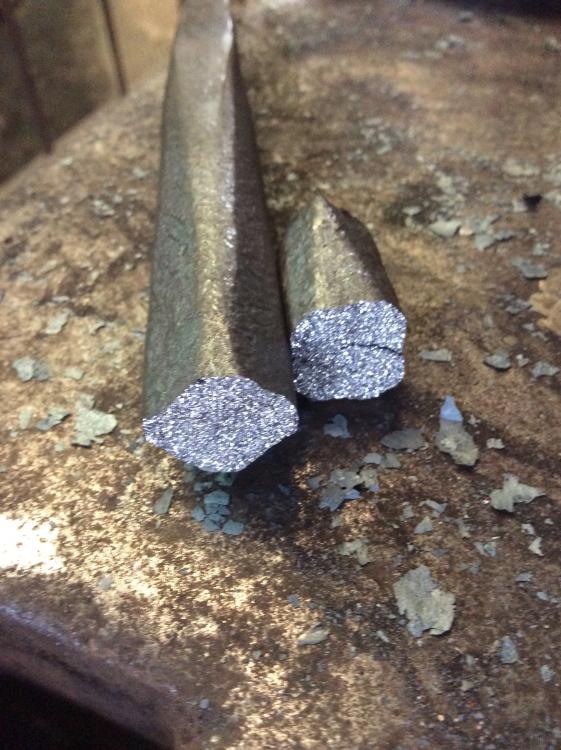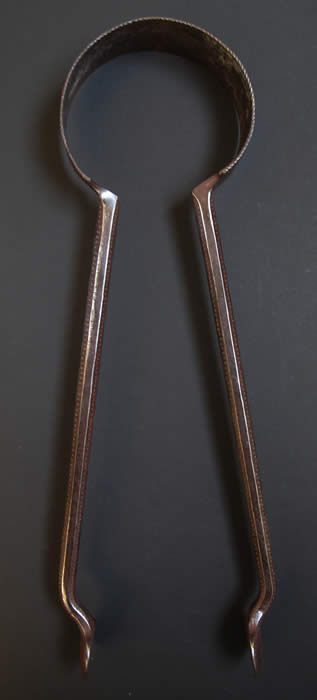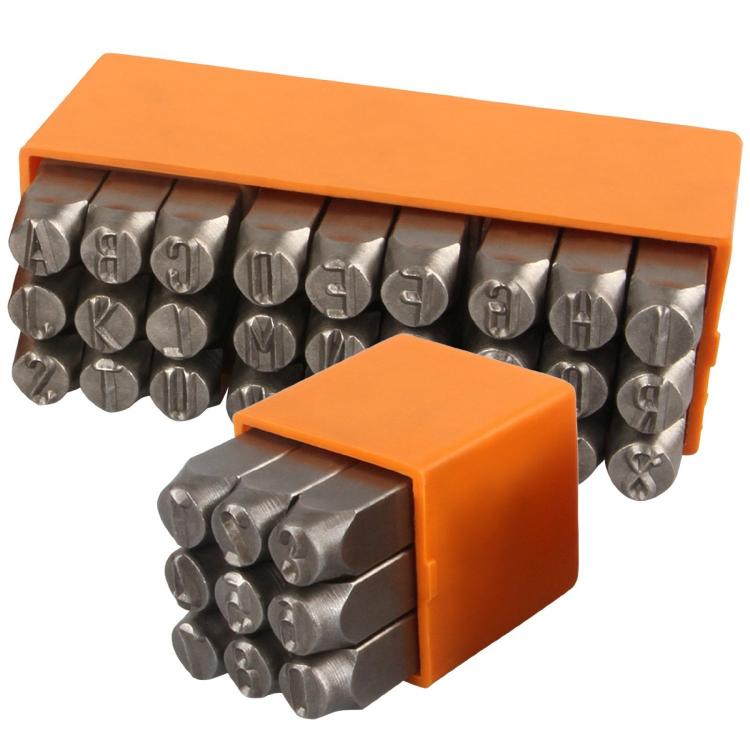-
Posts
116 -
Joined
-
Last visited
Content Type
Profiles
Forums
Articles
Gallery
Downloads
Events
Everything posted by blackleafforge
-
Hi, I want to drill in and then set the steel bars in it so they can hold fire tools.
-
I wanted to make some companion sets set in stone but don't have any experience with the stuff. After looking online I think I will go for limestone so I can carve a bit of detail on to it, but I am concerned about it cracking. Is limestone a good choice? if not does anyone have any experience or advice about the kind of stone to use? Thanks
-
Im trying to upgrade by punches and chisels as I am spending more and more time re dressing and sharpening. I started out wit EN9 which is nice to forge and forgiving but deformed easily. I then tried 01 and its much harder but I have had a few exiting instances of it shattering. I was looking over some farrier tools and they had a lot of S1 tools, they claimed to be very impact resistant, hard with good edge retention. A quick google didn't return any useful info about hand forging it and using it as a blacksmith. Does anyone have any experience with it?Is it the right steel to be using? Or is it another example of a mislabelled steel that is confusing me! Thanks
-
I did try offering to build something myself but they have to go through a planning process because of the buildings protected status before anything can be changed. Using charcoal is a good idea, I may pay the extra myself if they won't go for it if its significantly better.
-
I know there are already a few posts about the dangers and solutions to a badly ventilated forge, I was wondering however if anyone has info about or access to any scientific study carried out in a forge or similar. I ask because I work in a 17th century forge owned by a charitable group that keeps it open to the public - the main draw is the water powered trip hammer, im just a sideshow. The problem is that it all collapsed a century ago and was then re built, they however ran out of money so the roof is just solid asbestos sheeting, There are 2 open forges both burning coke ( there are plans to switch to cola soon), one has a very badly designed hood that is not original and does very little to draw any fumes and smoke away. The other one ( the one I use ) has no extraction and vents straight in to the room. I have been working there for two years now and in that time have had un explained headaches and come home covered in dust and coughing. I know this is a problem but I don’t have alternative premises. I have mentioned the issue to the managers but as always with charitable organisations money is very tight and they seem very un motivated to do anything in the short term. They have made the concession of installing a carbon monoxide sensor in the room that has not been triggered but I think the many holes and doors in the structure would stop any massive gaseous build up. My concern is more the particulate matter thrown up, like ash and dust and my exposure to the hot gasses and rubbish coming straight off the fire in to my face as I lean over it. I have organised a meeting with the area manager and was hoping to back up my argument for investment in some type of extraction by talking about the potential impact on elderly and young visitors and staff that spend a long time in the forge, like me. I know you guys are very knowledgable and I wondered if you are basing it of any studies? I wanted to be able to make an non emotional presentation with black and white proof that it its dangerous and very poor practice, helping to bump up extraction installation to the top of the to do list. Thanks for taking the time to read all that. Andy p.s the first pic shows my fire in the bottom corner and a view of the old machinery, the second is a closer view of my fire when starting it in the morning.
-

Heat treatment problems on punch head
blackleafforge replied to blackleafforge's topic in Tools, general discussion
I let it temper to a light straw, It did stand up to a few uses before breaking so I have lost the tempering colours on the end. -
Hi, Im having more problems with my chisels after moving from EN9 to 01 tool steel. Initially i got fractures at the business end that I was subsequently told due to the enlarged grain structure it was probably caused by me over heating during forging. So I forged a new set of punches and kept them at a lower heat and that seemed to solve the problem, but I now get large bits flaking off on the striking end. No enlarged grain structure and I had brought it up to critical, oil quenched the tip, let the temper run then re quenched the tip again and let the punch cool naturally under the forge ash. Have I missed something? I really like the toughness of 01 vs EN9 that I had to re forge every week but it seems much more temperamental, Is this the best steel to be using or am I just using it wrong? Thanks!
-
I assumed the crack was formed at the same time as the break as i didn't notice it before. Thinking back I did get the top half hotter than I liked (white heat), i was taught to forge EN9 at a red heat, is this true of 01? Can I save the bottom of the punch by annealing and re forging? Does annexing require a long cool down or is it sufficient to bring the pice up to non magnetic and quench straight away? Thanks.
-
Can anyone diagnose what the problem here is? I use EN9 for punches but I found the smaller ones bend after a few uses. So I have tried 01 steel, I forged, brought up to non magnetic, quenched half in linseed oil, allowed temper colours to reach end, re quenched half and left to cool under the forge ash. The first time i tapped it it snapped. What did i do wrong? thanks!
-
I hadn't considered dust / grit build up being a problem, I had thought that using a cutting fluid might help but it seemed overkill for a hand held drill. I do put a bit too much pressure on sometimes, especially with a blunt drill I sometimes force it through with all my weight out of frustration! I also didn't consider cleaning the metal, I assume thats to stop grit and crap getting pushed in to the hole? Same with the speed, I usually just crank it all up to 11, I hadn't considered that may be another contributory factor. Are there any other machinist brands you would recommend? as a lot of the ones discussed seem to mainly be available in the US. Also are you sharpening your bits by hand or using a jig or other automatic contraption? Thanks
-
I have been using a cheap set of drill bits that came with my drill for a while now and they are almost all broken or blunt. A fresh one only seems to last for about a minute of drilling through mild steel, is it worth investing in a very expensive set? I was looking at at 29 pice cobalt irwin set but it costs over £100. How much difference will I see? Does anyone else invest in expensive sets or is cheap and cheerful the way to go? Thanks
-
I have notice and heard smith make reference to the fact that working stock hard keeps the heat in. I find this mostly applicable when drawing down very small stock but I was wondering about what was going on. I assume that the impact of the hammer will generate a small about of heat through friction but I don't think that accounts for it. I thought it may have something to do with compression? I also noticed this video that i assume is working off the same principle. does anyone smarter than me know what exactly is going on?
-

Vibration damage to arm over time
blackleafforge replied to blackleafforge's topic in Safety discussions
what is the lump in the middle for? I will try playing around with a looser grip and see what i can achieve, hopefully without throwing my hammer at anyone! thanks -
I have met a few older blacksmiths who have problems with their arms and in some cases can't fully open the hand. I have been forging full time for almost a year and have already noticed some aches and pains creeping in along with a bit of numbness on the tips of my fingers. I have seen a few hammers being sold with anti vibration handles, e.g.: http://www.buyhorseshoes.co.uk/double-s-shoe-turning-hammer-18lbs-2lbs-or-22lbs-10165-p.asp are they any good? Has anyone used them? thanks
-
very impressive. reviewing the design and looking at yours i suspect i may not have thinned the flexing section enough...
-
Im sorry to say that the first picture is just an example i found and not one i made. I don't have it anymore but the client told me that they were developing in the flattened bending section. Its made with new mild steel bar, flattened to a fairly uniform thickness on the bend (about 3 mil). I tried to get a blue tempering colour on the flexing section as I was told that equated to a flexible state. I don't think i burnt it.
-
Hi, I recently made some tongs for picking up hot logs / bits of wood. The client described the design an I made it out of mild steel. It was all one pice with the flexible spine made by thinning out the material at the bend. It worked after a fassion but I didn't get a lot of movement and apparently cracks have now started to appear. I looked at similar designs online like the ones below and noticed that some had inserts riveted on to the bend. Am I heat treating the steel wrong, or is it to thick or will mild steel never have the correct flex and memory to be suitable for this type of application? thanks
-

Keeping lettering even?
blackleafforge replied to blackleafforge's topic in Tools, general discussion
thanks, as always a lot of good tips! -
Hi, I bought a set of punches with letters on them for writing customers names on items I'm making. I am however having real problems keeping them all straight and my efforts often look very amateurish and spoil the work. Am I missing something? Is there a method or tool that would do a better job? Also what temperature would you punch at? I didn't want to ruin the crisp edges of the letters so I have been doing it at just under a dull orange, is that correct? thanks
-
I recently priced up a job for hot zinc spraying and was surprised by how much it cost. For small jobs is a can a good alternative? I have never used them before but can they really compete with the larger industrial processes? thanks
-
Thanks. I have tried stressing the whole traditional craft thing and my willingness to work with them and modify my work practice but they seem very uninterested. It all just seems so counter intuitive and obstructive. The place I looked at before building my current workshop was a 300 year old forge in the countryside but the local planners would still not accept it could be used as a forge without an expensive and lengthly consultation because it had been vacant for 50 years! I would love to stay but I can't risk it still not being allowed to work even after I get further in to debt trying to keep them happy by changing my equipment or modifying my shop. I get the feeling they don't want to see me succeed and will be obstructive to the end. On a related note does anyone in the south west know of a vacant forge or similar?
-
Thanks for all the responses, they are appreciated. Alan, I was told by the owner of the industrial yard I am sited in that I came under his planning umbrella, B1 and B2 general use I think. But the local government disagree and have told me this afternoon that they also consider it a temporary structure because of its construction and type and I will also need to separately apply for retroactive planning permission, which they were disinclined to offer. They also suggested that because of my location the chimney may have to be over 10 meters high to mitigate damage to local air quality. I have only been operating for about 2 weeks and was just starting on my first commission. Anyway no use in dwelling on it but it now looks like I'm going to get closed down permanently. I was just shocked that all this law existed to shut me down, I did everything I could when setting this up with regards to informing the local council and checking the legal requirements but had never come across chimney registration. What are the rest of the smiths in the uk doing? Is everyone vulnerable to this kind of things or are established premises exempt or overlooked?
-
thanks for the info! very helpful
-
Has anyone ever been approached by the local council regarding chimney registration? The local council have asked me to cease operations while they look in to the requirements and have told me I would have to apply to re open and there would be a charge for the application in the region of a few hundred. I looked at a lot of planning law before I built my forge but this is completely new to me.
-
Someone close to me is selling this vice, I was going to go with a modern engineers vice but I have just restored an old leg vice and really enjoyed the process of bringing it back and love the look of it in my shop so I want to invest in another bit of usable history. The seller describes this as a solid steel victorian vice and is asking £70. Can anyone confirm its history and value? Thanks Andy forgot the pic

